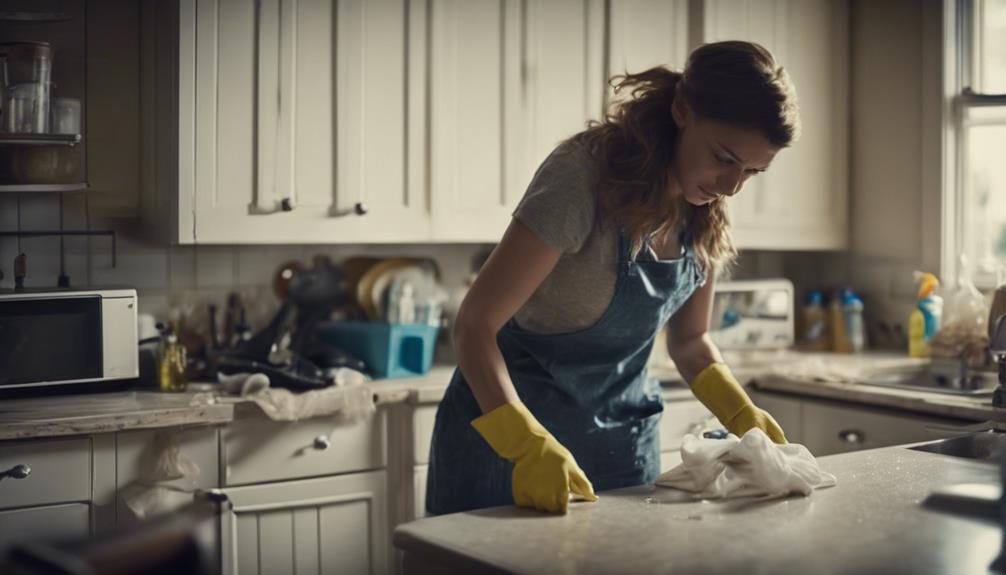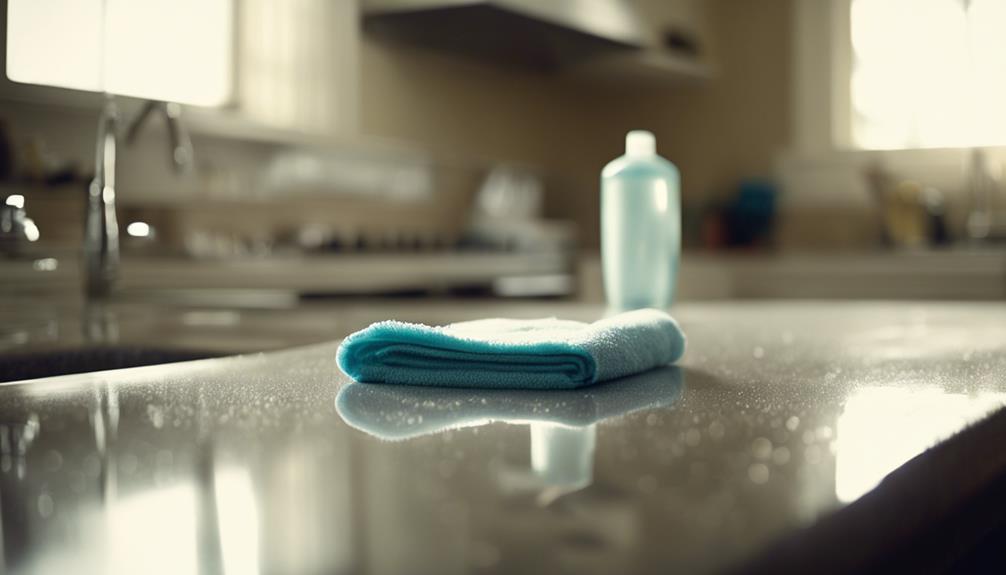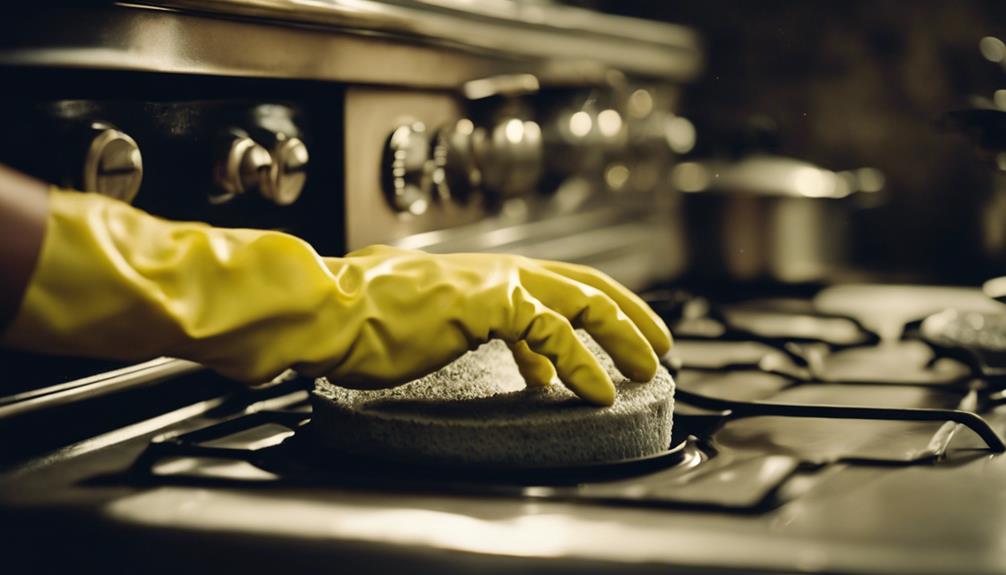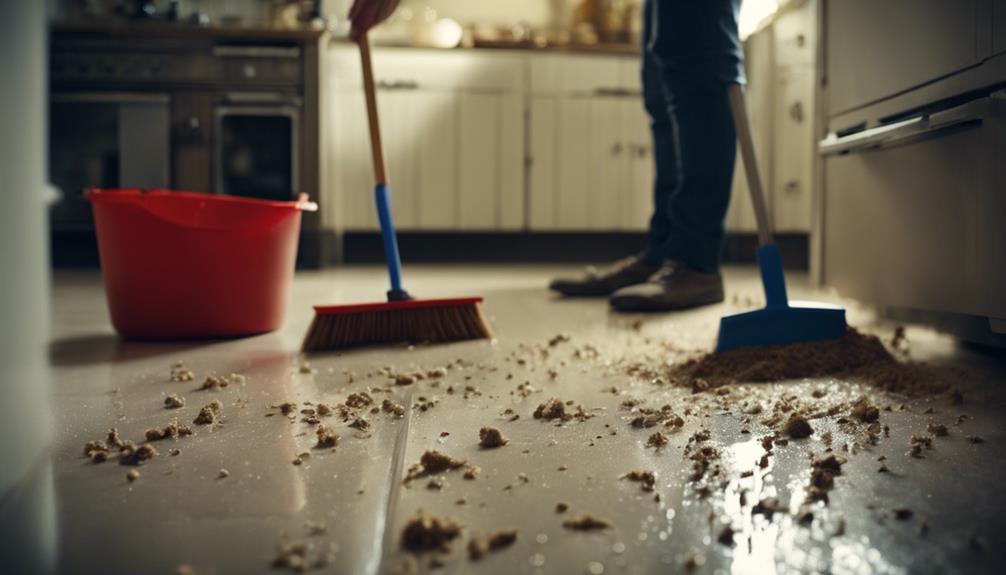Transform your kitchen into a spotless haven effortlessly. Start by dusting high areas, then empty and disinfect cupboards thoroughly. Deep clean the fridge by removing all items and wiping down surfaces. Wipe down kitchen surfaces regularly and organize lower cabinets for a polished look. Scrub the hob and oven till they sparkle. Sanitize the sink with baking soda and vinegar. Sweep, vacuum, and mop floors, paying extra attention to high-traffic areas. Freshen the garbage disposal regularly. Master these steps for a fresh and clean kitchen.
Key Takeaways
- Use appropriate cleaners for surfaces.
- Scrub and sanitize high-touch areas.
- Organize and clean cupboards regularly.
- Freshen sink with baking soda and vinegar.
- Maintain spotless floors and garbage disposal.
Essential Kitchen Cleaning Supplies
To effectively clean your kitchen, you must have essential supplies ready at hand. Start by ensuring you have cleaning gloves, microfiber cloths, sponges, scrubbers, dish soap, all-purpose cleaner, baking soda, vinegar, and floor cleaner. These items are vital for keeping your kitchen spotless.
When it's time to tackle the floor, use a suitable cleaner that can cut through grease and grime effectively. Vinegar, a natural disinfectant, is a versatile cleaner that can help eliminate odors and break down tough kitchen messes. Mix vinegar with water to create a powerful cleaning solution that's safe and eco-friendly for various surfaces in your kitchen.
Start With High Areas
When addressing your kitchen cleaning, it's important to start with high areas.
Dusting top cabinets and cleaning light fixtures will help prevent dirt from falling onto cleaned surfaces.
Dust Top Cabinets
Starting with the highest point in your kitchen, dusting the top cabinets is a crucial step in maintaining a clean and thorough environment. Use a microfiber cloth or duster to effectively remove dust and dirt from upper cabinets. Pay close attention to corners and edges where dust tends to accumulate.
Thoroughly dusting the top cabinets on a regular basis will help prevent dust from falling onto lower surfaces during cleaning. Make sure you cover all high areas meticulously before moving on to clean the lower surfaces.
Clean Light Fixtures
Begin by dusting off the light fixtures in your kitchen, starting from the highest points to prevent dust from settling on cleaned surfaces. Use a microfiber cloth or duster to gently wipe down the light fixtures, making sure to remove any accumulated dust and grime.
For a more thorough cleaning, take off any light covers or shades to access hard-to-reach areas. Don't forget to clean the light bulbs as well; use a dry cloth or a soft brush to maintain their brightness and prevent dust buildup.
Regularly cleaning your light fixtures not only enhances lighting efficiency but also helps maintain a bright and welcoming kitchen atmosphere. Keep up with this cleaning routine to guarantee your kitchen remains well-lit and inviting.
Thoroughly Clean Kitchen Cupboards

When addressing the task of cleaning your kitchen cupboards, make sure you empty them completely to access all surfaces effectively.
Use appropriate cleaning products like a mild cleaner or a mixture of vinegar and water to wipe down the interior thoroughly.
Pay close attention to removing sticky residue, spills, and stains to keep your cupboards looking fresh and well-maintained.
Empty Cupboards Completely
Removing all items from your kitchen cupboards is essential for thoroughly cleaning and sanitizing the interior surfaces. Empty the cabinets completely to access all areas for a deep clean. Wipe down shelves, walls, and doors to eliminate any food debris or spills.
Use appropriate cleaning products to disinfect and sanitize the cabinets, ensuring a fresh and hygienic kitchen environment. Before returning items, take the opportunity to organize them, maintaining order and accessibility.
Regularly spot clean your kitchen cupboards to prevent the accumulation of dirt and grime. By following these steps, you can keep your kitchen cabinets clean, organized, and free from harmful bacteria.
Use Appropriate Cleaning Products
To effectively clean your kitchen cupboards, start by selecting the appropriate cleaning products based on the material of your cupboards to prevent damage or discoloration. Use mild soap and water for wooden cupboards, while non-abrasive cleaners are suitable for laminate or painted surfaces.
Consider using specialized wood cleaners or polishes for wooden cupboards to maintain their finish and prevent drying out. Avoid harsh chemicals or abrasive scrubbing pads that can strip the finish or cause scratches on your kitchen cupboards.
Regularly wipe down kitchen cupboards with a damp cloth or sponge to remove dust, grease, and food splatters for a clean and fresh appearance. By using the right cleaning products, you can keep your cupboards looking their best.
Deep Clean the Fridge
For a thorough deep clean of your fridge, start by removing all items, including shelves and drawers. Take this opportunity to remove any expired items and discard spoiled food to maintain a clean and hygienic environment. Once everything is out, prepare a disinfectant solution using water, vinegar, and dish soap to clean the interior surfaces effectively. Don't forget to wipe down the fridge shelves, drawers, and door seals with this solution to guarantee any lingering bacteria and mold are eliminated.
As you clean, consider using baking soda to absorb odors and keep your fridge smelling fresh. This simple but effective trick can make a significant difference in maintaining a pleasant odor-free refrigerator. After cleaning all the surfaces and components, allow them to dry completely before placing the shelves and drawers back inside. By following these steps, you can be confident that your fridge isn't only clean but also safe for storing your food items.
Wipe Down Kitchen Surfaces

Clean your kitchen surfaces regularly using appropriate cleaners designed for each specific type of surface to effectively remove dirt, grease, and food residues. Use a suitable cleaner to wipe down surfaces like granite, laminate, or stainless steel.
Employ a microfiber cloth to ensure an efficient removal of dust, grease, and food particles. Pay close attention to high-touch areas such as handles, knobs, and switches to guarantee a thorough clean. Opt for gentle cleaning solutions over abrasive cleaners to prevent any damage to the surfaces.
It's essential to regularly wipe down kitchen surfaces to maintain cleanliness and prevent the accumulation of germs and bacteria. Consider using soapy water for a simple and effective cleaning solution. By incorporating these practices into your routine, you can keep your kitchen surfaces sparkling clean and hygienic for daily use.
Clean Lower Cabinets
Make sure that all items are removed from the lower cabinets to facilitate effective cleaning of the interior surfaces. Start by wiping down the cabinet doors, shelves, and drawers with a suitable cleaner to eliminate dust and grime buildup. Use a damp microfiber cloth to reach into hard-to-access corners and edges of the lower cabinets, ensuring a thorough clean.
While cleaning, take the opportunity to organize items within the lower cabinets. This not only maximizes the available space but also makes cleaning easier in the future. Once the surfaces are clean, finish by buffing them dry to achieve a polished and neat look.
Scrub the Hob and Oven

After ensuring your lower cabinets are clean and well-organized, shift your focus to scrubbing the hob and oven surfaces for a sparkling kitchen appearance.
Start by using a suitable cleaner and a scrubbing tool to tackle any food splatters and grease on the hob. For stubborn stains on the oven, make a paste using baking soda and water, apply it to the affected areas, and let it sit before scrubbing away the grime.
Don't forget to clean the oven racks separately by soaking them in hot, soapy water and scrubbing off any baked-on residue. Wipe down the inside and outside of the oven door to remove visible grime thoroughly.
Drain and Clean the Sink
Regularly sanitize and freshen up your kitchen sink by using a mixture of bleach, water, and dish soap. Start by plugging the sink and filling it with hot water, then add a cup of bleach, a squirt of dish soap, and mix well. Let it sit for a few minutes before draining and rinsing thoroughly with water.
For a deeper clean, scrub the sink with a mixture of baking soda and water using a scrub brush to remove any stubborn stains or residue. To tackle odors and keep your sink smelling fresh, pour a cup of distilled white vinegar down the drain and let it sit for about 30 minutes before rinsing with hot water.
Don't forget about the garbage disposal. Freshen it up by grinding a handful of ice cubes, a few lemon peels, and a mixture of baking soda and vinegar to eliminate any lingering odors. By following these steps, you'll make sure that your sink isn't only clean but also free from germs and unpleasant smells.
Sweep and Mop the Floor

For best cleanliness, start by sweeping the floor to remove loose dirt and debris, making sure you cover the entire surface area efficiently. Once the sweeping is complete, use a vacuum cleaner to capture fine dust particles and smaller debris that may have been missed. After you've swept and vacuumed, it's time to mop the floor using a suitable cleaning solution. Remember to pay extra attention to high-traffic areas where spills and stains are more likely to occur.
Here are some tips to help you effectively clean your floors:
- Consider using a grout cleaner for tile floors to guarantee a thorough cleaning of grout lines.
- For wood floors, follow specific maintenance techniques to preserve their quality and appearance.
- When mopping, use appropriate techniques for tile floors to avoid leaving streaks behind.
- Allow the floor to dry completely before walking on it to prevent leaving footprints or smudges.
Conclusion
Now that you've learned how to clean your kitchen like a pro, here's a fun fact to keep you motivated: Did you know that the average kitchen sink harbors more germs than a toilet seat?
By following these cleaning tips regularly, you can guarantee a safe and healthy environment for you and your family.
Happy cleaning!